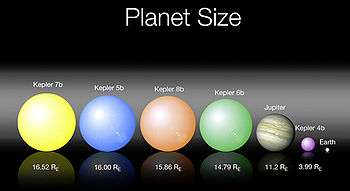Kepler-7
| Observation data Epoch J2000 Equinox J2000 | |
|---|---|
| Constellation | Lyra |
| Right ascension | 19h 14m 19.6s |
| Declination | +41° 5′ 23.3″ |
| Apparent magnitude (V) | 13.3 |
| Details | |
| Mass | 1.347 M☉ |
| Radius | 1.843 R☉ |
| Temperature | 5933 K |
| Age | 3.5 Gyr |
| Other designations | |
Kepler-7 is a star located in the constellation Lyra in the field of view of the Kepler Mission, a NASA operation in search of Earth-like planets. It is home to the fourth of the first five planets that Kepler discovered; this planet, a Jupiter-size gas giant named Kepler-7b, is as light as styrofoam.[1] The star itself is more massive than the Sun, and is nearly twice the Sun's radius. It is also slightly metal-rich, a major factor in the formation of planetary systems. Kepler-7's planet was presented on January 4, 2010 at a meeting of the American Astronomical Society.
Nomenclature and discovery
Kepler-7 received its name because it was the home to the seventh planetary system discovered by the NASA-led Kepler Mission, a project aimed at detecting terrestrial planets that transit, or pass in front of, their host stars as seen from Earth.[2] The planet orbiting Kepler-7 was the fourth planet to be discovered by the Kepler spacecraft; the first three planets combed from Kepler's data had been previously discovered, and were used to verify the accuracy of Kepler's measurements.[3] Kepler-7b was announced to the public on January 4, 2010 at the 215th meeting of the American Astronomical Society in Washington, D.C. along with Kepler-4b, Kepler-5b, Kepler-6b, and Kepler-8b. Kepler-7b was noted for its unusually and extremely low density.[1]
The planet's initial discovery by Kepler was verified by additional observations made at observatories in Hawaii, Texas, Arizona, California, and the Canary Islands.[4]
Characteristics
Kepler-7 is a sunlike star that is 1.347 Msun and 1.843 Rsun. This means that the star is about 35% more massive and 84% wider than the Sun. The star is estimated to be 3.5 (± 1) billion years old. It is also estimated to have a metallicity of [Fe/H] = 0.11 (± 0.03), meaning that Kepler-7 is approximately 30% more metal-rich than the Sun; metallicity plays a significant role in the formation of planetary systems, as metal-rich stars tend to be more likely to have planets in orbit.[5] The star's effective temperature is 5933 (± 44) K.[6] In comparison, the 4.6 billion-year-old Sun[7] releases less heat, with an effective temperature of 5778 K.[8]

The star has an apparent magnitude of 13.3, meaning that it is extremely dim as seen from Earth. It cannot be seen with the naked eye.[3] It is estimated to lie between 1000 and 1400 light years from the Solar System.[9]
Planetary system
Kepler-7b is the only planet that has been discovered in Kepler-7's orbit. It is .433 MJ and 1.478 RJ, meaning it is 43% the mass of planet Jupiter, but is nearly three halves its size. With a density of .166 grams/cc,[3] the planet is approximately 17% the density of water. This is comparable to styrofoam.[1] At a distance of .06224 AU from its host star, Kepler-7b completes an orbit around Kepler-7 every 4.8855 days.[3] Planet Mercury, however, orbits the Sun at .3871 AU, and takes approximately 87.97 days to complete one orbit.[10] Kepler-7b's eccentricity is assumed to be 0, which would give Kepler-7b a circular orbit by definition.[3]
| Companion (in order from star) |
Mass | Semimajor axis (AU) |
Orbital period (days) |
Eccentricity | Inclination | Radius |
|---|---|---|---|---|---|---|
| b | 0.433 MJ | 0.06224 | 4.8855 | 0 | — | 1.478 RJ |
See also
References
- 1 2 3 Rich Talcott (5 January 2010). "215th AAS meeting update: Kepler discoveries the talk of the town". Astronomy.com. Astronomy magazine. Retrieved 27 February 2011.
- ↑ "Kepler: About the Mission". Kepler Mission. NASA. 2011. Retrieved 27 February 2011.
- 1 2 3 4 5 6 "Summary Table of Kepler Discoveries". NASA. 2010-01-04. Retrieved 2010-01-06.
- ↑ "NASA's Kepler Space Telescope Discovers its FIrst Five Exoplanets". NASA. 4 January 2010. Retrieved 27 February 2011.
- ↑ Henry Bortman (12 October 2004). "Extrasolar Planets: A Matter of Metallicity". Space Daily. Retrieved 27 February 2011.
- ↑ "Notes for star Kepler-7". Extrasolar Planets Encyclopaedia. 2010. Retrieved 27 February 2011.
- ↑ Fraser Cain (16 September 2008). "How Old is the Sun?". Universe Today. Retrieved 27 February 2011.
- ↑ David Williams (1 September 2004). "Sun Fact Sheet". Goddard Space Flight Center. NASA. Retrieved 27 February 2011.
- ↑ Boyle, Alan. "How astronomers mapped the patchy clouds of an alien world". NBC News. Retrieved 3 October 2013.
- ↑ David Williams (17 November 2010). "Mercury Fact Sheet". Goddard Space Flight Center. NASA. Retrieved 27 February 2011.
Coordinates: ![]() 19h 14m 19.6s, +41° 5′ 23.3″
19h 14m 19.6s, +41° 5′ 23.3″